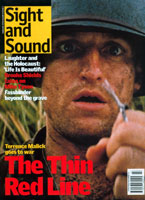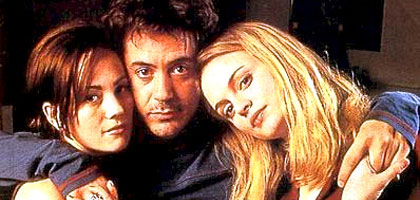
Two Girls and a Guy
USA 1997

Reviewed by Liese Spencer
Synopsis
Our synopses give away the plot in full, including surprise twists.
Two women, Lou and Carla, stand outside a Manhattan apartment each hoping to surprise her actor boyfriend on his return from a trip to Los Angeles. Lou starts chatting to Carla. As they talk it becomes clear that both women are seeing the same man. Lou breaks into the apartment and lets Carla in. Together they wait for Blake to return and compare notes. Through the window, the women see him arrive by taxi and hide. Blake comes into the apartment and leaves loving phone messages for both women. He plays the piano, phones his mother and his agent. Carla reveals herself and cryptically confronts him over his fidelity. Lou emerges and the women ask him how long he has been two-timing them. He has been seeing both women for three days a week each, claiming to visit his ill mother on the other days. Blake goes into the bathroom and pretends to commit suicide using a fake gun.
As the day progresses Blake makes repeated calls to his mother, and phones the doctor to express his anxiety over her health. Lou and Carla drink Tequila together. Carla and Blake have sex. Carla and Lou reveal they have both been unfaithful to Blake. Lou suggests a ménage à trois, is rejected and leaves, giving Carla her phone number. Some time later. Blake and Carla phone an undertakers to make arrangements for his mother's funeral.
Review
In 1987, Robert Downey Jr played a compulsive womaniser in James Toback's sunny romantic comedy The Pick-Up Artist. Over a decade later, actor and writer/director return to the same territory in Two Girls and a Guy, which sees Downey essaying the role of Blake Allen, a duplicitous cad cornered by the women he's two-timing and made to squirm under the spotlight of their dual interrogation. On the face of it, the film profiles a daring love triangle (a moderately raunchy sex scene between Downey and co-star Heather Graham nearly cost the film a N-17 rating in the US). In fact, it's an old-fashioned romance between a director and his star. After The Pick-Up Artist, Toback has said that he was left feeling they could do something "far bolder". According to the director, after seeing Downey in handcuffs on his way to prison, he knew he was "ready", and wrote him this vehicle.
A more sombre and dramatic treatment of infidelity than their former collaboration, Two Girls and a Guy plays on the off-screen notoriety of both director and star. Toback is a legendary womaniser, Downey a talent tarnished by drug addiction. As it details Blake's feints and evasions, his vanity, aggression and sophistry, Toback's merciless portrait of male selfishness seems an act of contrition from two ex-hellraisers.
In fact, the film is not so much a critique of male narcissism as a product of it. When he wrote him the role, Toback may have believed he was modelling the feckless Blake on Downey (it's certainly impossible not to view Blake's smug amorality and little-boy charm in a harshly ironic light given Downey's history), but the character is closer to his own. What's more, despite its acute observation, Toback's film is less an apology than a celebration of the romantic, male egotist. Sure Blake is weak and ridiculous while the women are strong and dignified, but the bottom line is that they (and we) are supposed to forgive Blake because he's charming. Whether you do or not depends largely on whether you're prepared to indulge Downey as much as Toback. As Blake, Downey proves he has chutzpah to spare, but some may still find it hard to understand why two beautiful and intelligent women would be competing for his wheedling mummy's boy.
In a way, Downey's camp performance fits perfectly with the exaggerated, theatrical tone of this obsessive little melodrama. A three-hander set largely in real time, Toback's densely written chamber piece is described by producer Ed Pressman as a "post-romantic" comedy. For Toback it was clearly conceived as a Serious Entertainment, his staccato script rapping out a self-consciously clever anatomy of modern relationships which veers between cerebral farce, emotional bombast (in one scene Blake recites Hamlet to underline his Oedipal relationship with his mother) and giddy implausibility.
Powered by Toback's fizzing dialogue and strong performances from all three stars (Heather Graham's cool Carla and Natasha Wagner's streetwise Lou prove more than a match for Downey's showboating charisma), the film sustains its comedy of ideas surprisingly well, working best in a light, comic register. "I'm talking about Mormonism," Wagner's Lou says earnestly, when hinting at a ménage à trois. "I think you mean bigamy," Blake replies.
But somewhere along the line the dramatic tension evaporates. Listening to Toback's solipsistic characters relentlessly chewing over their desires becomes an enervating, confessional experience. In the end, Two Girls and a Guy is a bit like watching a cross between a Harvard student review and a highbrow edition of Oprah with studio sofas replaced by the Japanese-style screens of a fashionable SoHo loft.
Credits
- Producers
- Edward R. Pressman
- Chris Hanley
- Screenplay
- James Toback
- Director of Photography
- Barry Markowitz
- Editor
- Alan Oxman
- Production Designer
- Kevin Thompson
- ©Two Girls Inc
- Production Companies
- Fox Searchlight Pictures presents an Edward R. Pressman production
- Produced in association with Muse Productions
- Executive Producers
- Michael Mailer
- Daniel Bigel
- Bigel/Mailer Films
- Line Producer
- Gretchen McGowan
- Pressman Executives in Charge of Production
- NY:
- Erin O'Rourke
- LA:
- Wendi Friedman
- Muse Executives in Charge of Production
- Jordan Gertner
- Timothy W. Peternel
- Production Co-ordinator
- Eileen Cabiling
- Unit Production Manager
- Pamela Thur
- Post-production
- Services:
- Warmflash Productions
- Supervisor:
- Robert Warmflash
- Assistant Directors
- John Gallagher
- Jamie Miller
- Christopher S. Campbell
- Script Supervisor
- Catherine Gore
- Casting
- Sheila Jaffe
- Georgianne Walken
- Associate:
- Carmel Kubasik
- Associate Editor
- Char Hamer
- Set Decorator
- Alisa Grifo
- Paintings
- Charles Lassiter
- Wardrobe
- Renata Chaplynsky
- Key Make-up/Hair
- Meredith Soupios
Titles/Opticals- Cynosure Visuals
- Music Supervisor
- Barry Cole
- Soundtrack
- "You Don't Know Me" by Cindy Walker, Eddy Arnold, performed by (1) Jackie Wilson, (2) Dubcheck & Sarah Shannon of Velocity Girl; "Gloria" from "Cum sancto spiritu" by Antonio Vivaldi, performed by the Christ Church Cathedral Choir, conducted by Simon Preston; "Adagio mesto" & "Finale: allegro con brio" from "Horn Trio in E Flat Major Op. 40" by Johannes Brahms, performed by Vladimir Ashkenazy, Radovan Vlatkovic; "Slapper Song" &s "Boom" by/performed by Dubcheck; "Snake" by/performed by Robert Downey Jr
- Choreography
- Patrica Moreno
- Mixer
- Bill Markle
- Production Mixers
- Brian Miksis
- Itamar Ben Jacob
- Supervising Sound Editor
- Bill Markle
- ADR
- Los Angeles Engineer:
- Paul Drenning
- London Engineer:
- Ted Swanscott
- Stunt Co-ordinator
- Danny Aiello Jr
- Cast
- Robert Downey Jr
- Blake Allen
- Heather Graham
- Carla
- Natasha Gregson Wagner
- Lou
- Angel David
- Tommy
- Frederique Van Der Wal
- Carol
- Certificate
- 18
- Distributor
- 20th Century Fox (UK)
- 7,592 feet
- 84 minutes 21 seconds
- Colour by
- Technicolor
